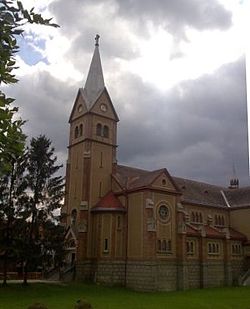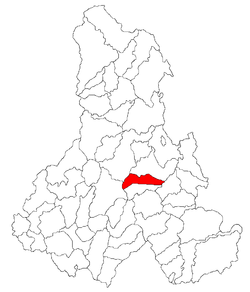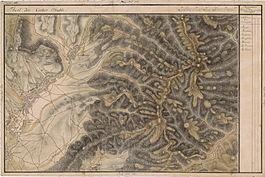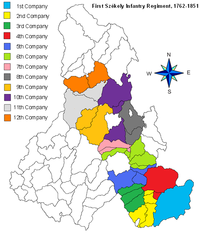- Dăneşti, Harghita
-
Dăneşti
Csíkdánfalva— Commune — Roman Catholic church 
Coat of armsLocation of Dăneşti, Harghita Location of Dăneşti, Harghita Coordinates: 46°31′0″N 25°45′0″E / 46.516667°N 25.75°ECoordinates: 46°31′0″N 25°45′0″E / 46.516667°N 25.75°E Country  Romania
RomaniaCounty Harghita County Status Commune Government – Mayor Jenő Süket[1] (Democratic Union of Hungarians in Romania) Area – Total 61.73 km2 (23.8 sq mi) Population (2002) – Total 2,315 Ethnicity[2] – Hungarians 98.7% – Romanians 0.8% Time zone EET (UTC+2) – Summer (DST) EEST (UTC+3) Postal Code 537070 Area code(s) +40 234 Website www.danfalva.ro Dăneşti (Hungarian: Csíkdánfalva or colloquially Dánfalva, Hungarian pronunciation: [’tʃiːkdaːnfɒlvɒ]) is a commune in Harghita County, Romania. It lies in the Székely Land, an ethno-cultural region in eastern Transylvania. The commune is composed of a single village, Dăneşti. It also included Mădăraş until 2002, when it was split off to form a separate commune.
Contents
History
It was first recorded in 1567 as Danffalwa and in 1576 as Dánfalva. Its name derives from the Hungarian and means 'Daniel's village' using the archaic Hungarian form of the name. Until 1919, its Romanian name used to be Danfalău, which was then Romanianized to the current official name.[3]
Until 1779, villagers were engaged in the operation of iron hammers, but in the 19th century it became a potters' village. Today, it has a black pottery factory. The village provided servicemen for the 7th Company of 1st Székely Infantry Regiment until 1851. Wood processing, animal-breeding and transportation were the main preoccupation of the villagers.
The village administratively belonged to Csíkszék district in the Kingdom of Hungary until the administrative reform of Transylvania in 1876, when it fell within Csík County. After the Treaty of Trianon of 1920, the village, like the rest of Tranylvania, became part of Romania and fell within Ciuc County during the interwar period. In 1940, the second Vienna Award granted Northern Transylvania to Hungary and the village was held by Hungary until 1944. After Soviet occupation, the Romanian administration returned and the village became officially part of Romania in 1947. Between 1952 and 1960, the village fell within the Magyar Autonomous Region, between 1960 and 1968 the Mureş-Magyar Autonomous Region. In 1968, the province was abolished, and since then, the commune has been part of Harghita County.
Geography
It is located 21 km north of the county seat where the Köd Brook enters the Olt River. The commune is cut by the road E 578 and a railway line. Its natural resources: iron ore, mercury, kaolin, cinnabar, mineral water.
Demographics
The commune has an absolute Hungarian (Székely) majority. According to the 2002 census it has a population of 2315 of which 98.7% or 2,287 are Hungarian.[4]
Landmarks
- Its Roman Catholic Church was built between 1922 and 1935 consecrated in honour of the Immaculate Conception. It is surrounded by a fortified wall, strengthened by a tower. Not far from the church, stands the memorial column of Queen Elisabeth of Hungary,
- 1.5 km west of the village, a thermal spa with a water of 21 °C can be visited at Dugásfürdő which was established in 1926,
- Sándor Petőfi School Center.
Notable people
The following notable people were born here:
- Áron Antal (1881 - 1966): writer
- Antal Albert (1929-2005): editor-in-chief of local Hungarian newspaper Hargita Népe
- Ernő Albert (1932-): ethnographer
- Pál János (1921-): curator, ethnograher
- Márton Zsigmond (1947-): painter, mosaicist
Twinning
The commune is twinned with
External links
- Official website (Hungarian)
- Dugásfürdő Mineral Water Spa (Hungarian)
- Village map
References
- ^ Central Electoral Bureau
- ^ "Etnikai statisztikák" (in Hungarian). Árpád E. Varga. http://www.kia.hu/konyvtar/erdely/erd2002.htm. Retrieved 2010-05-20.
- ^ János András Vistai. "Tekintő – Erdélyi Helynévkönyv". p. 217.Transylvanian Toponym Book
- ^ "Etnikai statisztikák" (in Hungarian). Árpád E. Varga. http://varga.adatbank.transindex.ro/?pg=3&action=etnik&id=2125. Retrieved 2010-05-20.
Harghita County, Romania Cities Miercurea-Ciuc (county seat) · Gheorgheni · Italic text Odorheiu Secuiesc · Topliţa

Towns Băile Tuşnad · Bălan · Borsec · Cristuru Secuiesc · Vlăhiţa
Communes Atid · Avrămeşti · Bilbor · Brădeşti · Căpâlniţa · Cârţa · Ciceu · Ciucsângeorgiu · Ciumani · Corbu · Corund · Cozmeni · Dăneşti · Dârjiu · Dealu · Ditrău · Feliceni · Frumoasa · Gălăuţaş · Joseni · Lăzarea · Leliceni · Lueta · Lunca de Jos · Lunca de Sus · Lupeni · Mădăraş · Mărtiniş · Mereşti · Mihăileni · Mugeni · Ocland · Păuleni-Ciuc · Plăieşii de Jos · Porumbeni · Praid · Racu · Remetea · Săcel · Sâncrăieni · Sândominic · Sânmartin · Sânsimion · Sântimbru · Sărmaş · Satu Mare · Secuieni · Siculeni · Şimoneşti · Subcetate · Suseni · Tomeşti · Tulgheş · Tuşnad · Ulieş · Vărşag · Voşlăbeni · Zetea
Localities which belonged to the First Székely Infantry Regiment from 1762 till 1851 1st Company Újfalu (Caşinu Nou) • Jakabfalva (Iacobeni) • Imperfalva (Imper) • Al-Tiz (Plăieşii de Jos) • Fel-Tiz (Plăieşii de Sus)2nd Company 3rd Company Tsátószeg (Cetăţuia) • Tsik-Szent-Király (Sâncrăieni) • Tsik-Szent-Simon (Sânsimion) • Tsik-Szent-Imre (Sântimbru)4th Company Ménaság (Armăşeni) • Bánfalva (Bancu) • Tsik-Szent-György (Ciucsângeorgiu) • Tsik-Szent-Márton (Sânmartin)5th Company Várdótfalva (Şumuleu Ciuc) • Tsik-Szent-Lélek (Leliceni) • Taplitza (Topliţa Ciuc, în Miercurea Ciuc) • Mindszent (Misentea) • Tsobotfalva (Cioboteni, în Miercurea Ciuc) • Tsomortány (Şoimeni)6th Company Borzsova (Bârzava) • Delne (Delniţa) • Szépviz (Frumoasa) • Tsik-Szent-Mihály (Mihăileni) • Tsik-Szent-Miklós (Nicoleşti) • Pálfalva (Păuleni-Ciuc) • Göröttsfalva (Racu) • Vatsártsi (Văcăreşti)7th Company 8th Company Tsik-Szent-Domokos (Sândominic) • Tsik-Szent-Tamás (Tomeşti)9th Company 10th Company Karczfalva (Cârţa) • Szent-Miklós (Gheorgheni) • Tekerıpatak (Valea Strâmbă)11th Company Al-Falu (Joseni) • Szárhegye (Lăzarea)12th Company Categories:- Harghita County geography stubs
- Communes in Harghita County
- Székely communities
Wikimedia Foundation. 2010.





